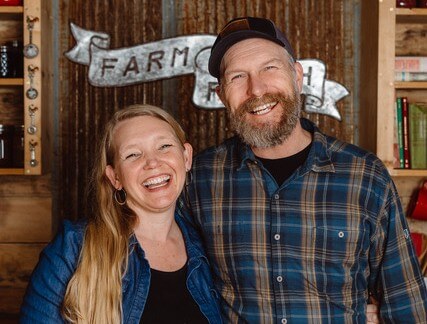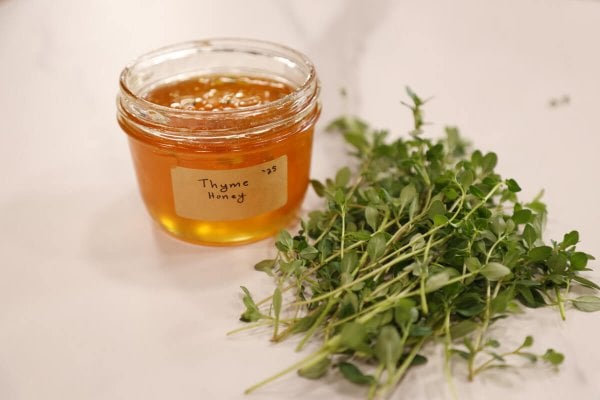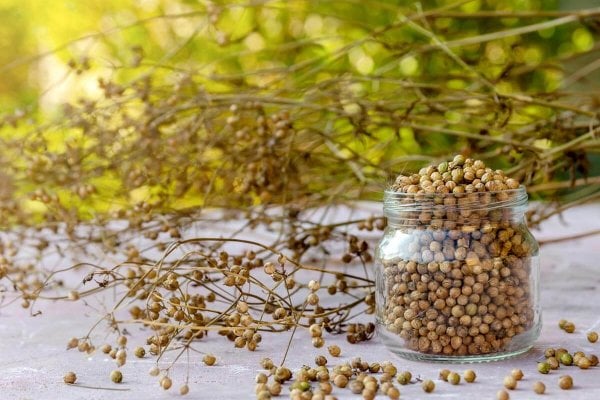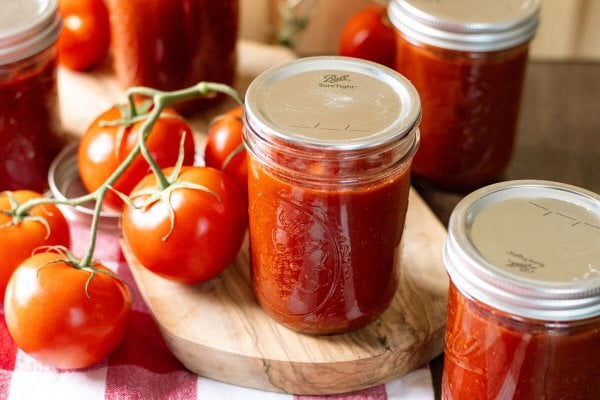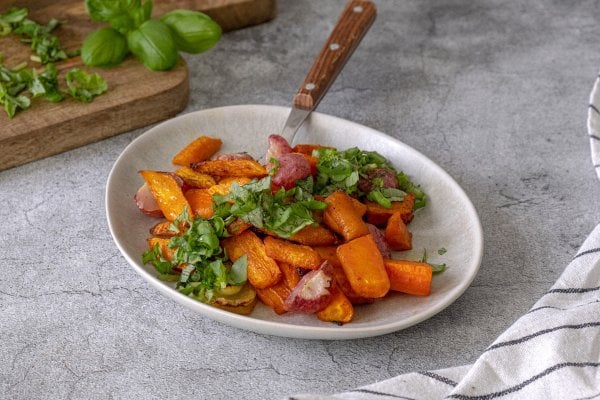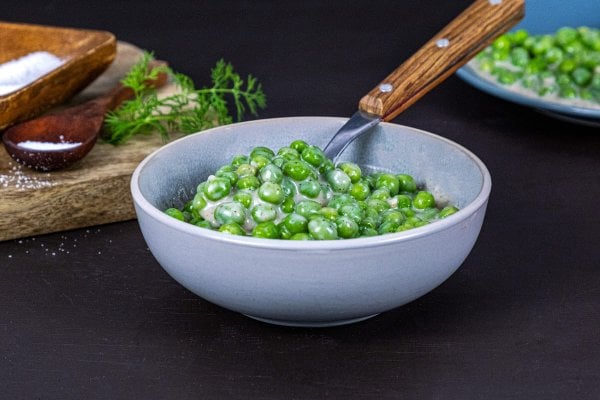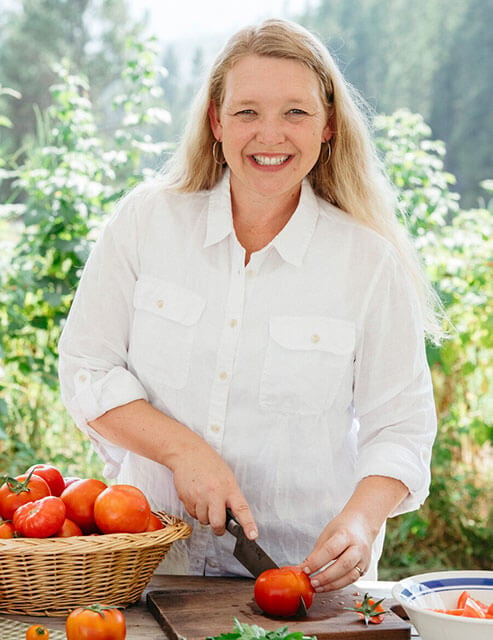Looking for a dish for a special Thanksgiving or Christmas tradition? This chestnut stuffing recipe is a great alternative to the standard sausage stuffing and pairs perfectly with your juicy roasted spatchcock turkey, fluffy Parkerhouse rolls, mashed potatoes,homemade cranberry sauce, and pecan pie. You can make the classic recipe or try a mushroom, apple, apricot, or cranberry variation included below.

Table of Contents
ToggleWhy We Love Chestnut Stuffing
We love historical recipes, like making pecan pie without corn syrup or pumpkin pie completely from scratch. Recapturing traditional recipes from times past creates a connection to our roots, and quite frankly, they taste better, too!
Chestnut stuffing is a truly American Thanksgiving side dish. In fact, the first stuffing recipe published in the United States was from 1772 and included chestnuts. However, chestnuts have fallen out of regular rotation in American cuisine, partly because of a blight that killed off up to 99 percent of American chestnut trees by 1940.
If you struggle to find chestnuts locally, I recommend talking to the produce manager at your local grocery store – they can often special order them for you. This chestnut stuffing is a staple on our holiday table. The flavor can’t be beat. We love it, and I think you will, too!
Chestnut Stuffing Recipe Variations
Do you like to add a twist to your holiday dishes to make them unique? These variations offer a range of flavors to suit any taste. Feel free to experiment and create a stuffing that’s uniquely yours.
| Ingredient | Flavor Profile | Suggested Combinations |
| Sausage | Savory | Chestnuts, fresh herbs, cranberries |
| Apple | Sweet and Tart | Chestnuts, onions, celery |
| Cranberry | Tangy | Chestnuts, sausage, fresh thyme |
| Mushroom | Earthy | Chestnuts, garlic, fresh sage |
| Apricot | Fruity | Chestnuts, parsley, almonds |

Tips for the Best Chestnut Stuffing
Following these cooking tips can turn a simple dish into a perfect chestnut stuffing. It will be full of flavor and have the perfect texture:
- Use Fresh Ingredients – Start with the freshest ingredients. Fresh chestnuts really make a difference in taste and texture.
- Properly Prepare the Chestnuts – Make sure to peel them well to avoid bad textures in your stuffing. You can also prepare roasted and peeled chestnuts ahead of time. Roast them, peel them and then freeze them whole in a freezer-safe container (remove as much air as possible). Freeze them for up to three months. When ready to bake, thaw them in the refrigerator, chop them and continue with the stuffing recipe.
- Keep it Moist – It’s important to add enough broth or stock. No one wants dry stuffing, but take care not to add too much, or it can also become soggy.
- Day-old Bread is Best – Slightly stale bread works best, so be sure to take your bread out a day in advance, cube it and leave it uncovered in a bowl or spread on a baking sheet to get stale. Stale bread absorbs liquid better, giving your stuffing a great texture. The size of the bread will also affect the texture. Larger pieces will be less soft, while smaller pieces will create more of a “bread pudding” texture.
- Season Generously – Don’t hold back on herbs and spices. Good seasoning brings out the chestnut and other flavors.

The Homestead Kitchen
This recipe for chestnut stuffing was featured in issue No.27 of the Homestead Kitchen magazine. If you are ready to master your homestead kitchen, this affordable magazine was curated with you in mind.
It’s packed full of cream-of-the-crop homesteading information, including recipes, DIY instructions, inspirational stories, homesteading hacks, book reviews, gardening tips, kids’ projects and more. We can’t wait to share it with you!
If you want to spend less time striving in the kitchen and more time enjoying it, then subscribe today to have your monthly copy delivered right to your mailbox.
Now, onto the chestnut stuffing recipe…

How to Make Chestnut Stuffing
Supplies Needed
- Sharp Knife – Practice basic knife sharpening skills to keep your tools in safe working order.
- Saucepan – A one-quart saucepan is a good size.
- Large Skillet – We generally choose cast iron cookware but use whatever skillet you have.
- 9×13″ Baking Dish – You can use an equal-sized casserole dish or split the recipe between two 8×8″ baking dishes.
- Mixing Bowl – We love these glass mixing bowls, but any medium-sized bowl will do.
- Whisk – If you don’t have a whisk handy, you can just use a fork.

Ingredients Needed
- 2 Cups Chestnuts – If you have difficulty finding chestnuts in your area, talk to your local produce manager about placing a special order.
- 1 1⁄2 Cups Butter – Learn how to make homemade butter here. If you’re using unsalted butter, you may want to increase the amount of salt in the recipe.
- 1⁄2 Cup Chopped Onion – Yellow, white, or red onions work great for this recipe.
- 1 tsp Salt – I highly recommend a high-quality salt such as Redmond Real Salt or kosher salt. (Using that link for Redmond Salt will automatically give you 15% off your order!)
- 1⁄4 tsp Pepper – Freshly ground black pepper is more potent. If you don’t have freshly ground, you may need to use a bit more. Follow your taste buds!
- 2 tsp Poultry Seasoning – If you don’t have poultry seasoning on hand, try our homemade poultry seasoning recipe or mix up 2 parts sage, 1 ½ parts thyme, 1 part marjoram, 1 part rosemary, and ½ part nutmeg.
- 1 Loaf of Bread, Cubed – Choose a bread with a mild flavor, such as sourdough, whole wheat sandwich bread, basic gluten-free bread, or an artisan loaf made from no-knead dough.
- 3 Eggs – Always use best practices when handling farm-fresh eggs.
- 1⁄4 Cup Milk – Always use best practices to process raw milk at home.
- Chicken Stock – We use homemade bone broth, but store-bought chicken or vegetable stock also works.



Step-by-Step Directions
- Preheat your oven to 350°F.
- With a sharp knife, score an X in each chestnut. Put scored chestnuts in a saucepan, cover with water, and boil for 20-30 minutes.
- Drain boiled chestnuts, peel off their hard skins and chop the meat inside.
- Melt the butter in a large skillet over medium heat. Add the chopped chestnuts, onion, poultry seasoning, salt and pepper. Cook until the onion is tender, 3-5 minutes.
- Toss chestnut mix with bread cubes in a 9×13 pan.
- In a medium bowl, beat together eggs and milk until consistent. Drizzle this liquid over the bread mixture. If the bread still appears very dry, drizzle broth over the top to add moisture.
- Bake stuffing in a preheated oven for 35-45 minutes until the top is crispy and golden brown.

Did you try this chestnut stuffing recipe? If so, please leave a star rating in the recipe card below. Then snap a photo and tag us on social media @homesteadingfamily so we can see!
How to Store Chestnut Stuffing
If preparing this recipe ahead of time, cool the stuffing to room temperature and store it in an airtight container in the fridge (either wrapped in plastic wrap or in a food-safe, air-tight container). Reheat by adding a bit of stock, covering with foil, and warming in the oven. Always check food safety and consume within a few days.

FAQ
Chestnut stuffing is a holiday dish with roasted chestnuts, bread, herbs, and spices. It’s a mix of flavors and textures, often with turkey or pork. The chestnuts add a sweet, nutty taste.
You’ll need fresh chestnuts, day-old bread, herbs like sage and thyme, and aromatics like onion and celery. Also, use good-quality chicken or vegetable stock for flavor.
Yes! You can add breakfast sausage or wild game sausage for a savory taste, diced apple or cranberry for sweetness, or sautéed mushrooms for earthiness. Diced apricot adds a fruity flavor that goes well with the chestnuts.
Soaking chestnuts is a topic of debate. Some say it helps with peeling, while others don’t think it’s necessary. If you soak, do it in warm water for about 30 minutes before roasting.
If chestnuts are not available, walnuts or pecans can be good substitutes. They offer a similar nutty taste and a nice crunch.
Roasted chestnuts are linked to Christmas through holiday songs and literature. Roasting them on an open fire is a festive experience that brings nostalgia.
Make a small incision on each nut to prevent bursting. Preheat the oven to 350 degrees and roast the chestnuts in a single layer on baking sheets until tender. For a real experience, use a cast-iron pan over an open fire, stirring often.
Chestnut stuffing pairs well with red and white wines. A full-bodied Chardonnay or a smooth Pinot Noir complements the stuffing’s flavors without overpowering them.

Other Posts You May Enjoy
- Homesteading Family’s Thanksgiving Traditions
- Roast Goose Recipe: A Crispy Holiday Classic
- Parker House Rolls Made With Sourdough
- Homemade Pumpkin Pie Recipe – From Scratch
- Homemade Pie Crust Recipe
- Creamed Onions

Chestnut Stuffing Recipe
Equipment
- sharp knife
- Saucepan
- Large Skillet
- 9×13 Baking Dish
- Mixing Bowl
- Whisk
Ingredients
- 2 cups chestnuts
- 1 1/2 cups butter
- 1/2 cup onion chopped
- 1 teaspoon salt
- 1/4 teaspoon black pepper
- 2 teaspoons poultry seasoning
- 1 loaf bread day-old, cubed
- 3 whole eggs
- 1/4 cup milk
- chicken stock if needed
Instructions
- Preheat your oven to 350°F.
- With a sharp knife, score an X in each chestnut. Put scored chestnuts in a saucepan, cover with water, and boil for 20-30 minutes.
- Drain boiled chestnuts, peel off their hard skins and chop the meat inside.
- Melt the butter in a large skillet over medium heat. Add the chopped chestnuts, onion, poultry seasoning, salt and pepper. Cook until the onion is tender, 3-5 minutes.
- Toss chestnut mix with bread cubes in a 9×13 pan.
- In a medium bowl, beat together eggs and milk until consistent. Drizzle this liquid over the bread mixture. If the bread still appears very dry, drizzle broth over the top to add moisture.
- Bake stuffing in a preheated oven for 35-45 minutes until the top is crispy and golden brown.
Notes
Chestnut Stuffing Recipe Variations
Do you like to add a twist to your holiday dishes to make them unique? These variations offer a range of flavors to suit any taste. Feel free to experiment and create a stuffing that’s uniquely yours.| Ingredient | Flavor Profile | Suggested Combinations |
| Sausage | Savory | Chestnuts, herbs, cranberries |
| Apple | Sweet and Tart | Chestnuts, onions, celery |
| Cranberry | Tangy | Chestnuts, sausage, fresh thyme |
| Mushroom | Earthy | Chestnuts, garlic, fresh sage |
| Apricot | Fruity | Chestnuts, parsley, almonds |
Tips for the Best Chestnut Stuffing
Following these cooking tips can turn a simple dish into a perfect chestnut stuffing. It will be full of flavor and have the perfect texture:- Use Fresh Ingredients – Start with the freshest ingredients. Fresh chestnuts really make a difference in taste and texture.
- Properly Prepare the Chestnuts – Make sure to peel them well to avoid bad textures in your stuffing. You can also prepare chestnuts ahead of time. Roast them, peel them and then freeze them whole in a freezer-safe container (remove as much air as possible). Freeze them for up to three months. When ready to bake, thaw them in the refrigerator, chop them and continue with the stuffing recipe.
- Keep it Moist – It’s important to add enough broth or stock. No one wants dry stuffing, but take care not to add too much, or it can also become soggy.
- Day-old Bread is Best – Slightly stale bread works best. It absorbs liquid better, giving your stuffing a great texture. The size of the bread will also affect the texture. Larger pieces will be less soft, while smaller pieces will create more of a “bread pudding” texture.
- Season Generously – Don’t hold back on herbs and spices. Good seasoning brings out the chestnut and other flavors.

